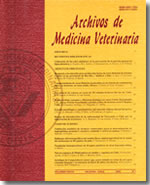Concentration of glycosaminoglycan, aldehydes and protein in synovial fluid from normal and damaged equine metacarpophalangeal joints
Main Article Content
Abstract
The purpose of this study was to evaluate the influence of severity of osteoarthritis on the concentration of degradation products from the cartilage extracellular matrix on synovial fluid. Total protein and aldehyde group concentrations were determined as indicators of collagen degradation. The concentration of glycosaminoglycans (GAGs) in sinovial liquid was also determined, both the total amount (GAGsT) and the fractions corresponding to the GAGs other than hyaluronic acid or sulfated GAGs (GAGsG), that consist mostly of chondroitin and keratin sulfate. The hyaluronic acid content of the synovial fluid was calculated as the difference between the concentrations of GAGsT and GAGsS. Samples of synovial fluid were collected from metacarpophalangeal joints of crossbred equines immediatelly after slaughter, by aseptic needle aspiration and then, following post mortem joint examination, were divided into four groups: a normal group as control (n = 17 ) and three alterated groups, obtained from joints with different degrees damage (+ = 15 ; ++ = 12 and +++ = 18 samples). The synovial fluid aldehyde concentrations were determined by a colorimetric reaction between aliphatic aldehydes and N-Methyl Benzothiazolidon Hydrazone. A colorimetric method with Alcian Blue using different MgCl2 concentrations, was used to quantify GAGsT and GAGsS. These results showed an increase of total protein concentration in the more alterated group (+++) (P < 0,05). The collagen degradation product concentration increased in the group less altered (+) compared whith the more alterated group (+++) and collagen protein concentration showed an increase in both less alterated groups (+ and ++) compared with the more alterated group (+++) (P < 0,05). The GAGsT, GAGsS and hyaluronic acid concentrations did not show statisticant differences between groups. GAGsT and hyaluronic acid concentrations showed a tendency to decrease in the more damaged samples. These results indicate that collagen degradation product concentration in synovial fluid could be used as a marker of initial changes in the osteoarthritis process.

